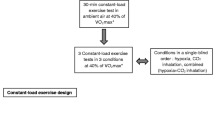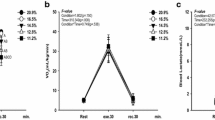Summary
The effect of acute hypoxia and CO2 inhalation on leg blood flow (LBF), on leg vascular resistance (LVR) and on oxygen supply to and oxygen consumption in the exercising leg was studied in nine healthy male subjects during moderate one-leg exercise. Each subject exercised for 20 min on a cycle ergometer in four different conditions: normoxia, normoxia +2% CO2, hypoxia corresponding to an altitude of 4000 m above sea level, and hypoxia +1.2% CO2. Gas exchange, heart rate (HR), arterial blood pressure, and LBF were measured, and arterial and venous blood samples were analysed for \(P_{{\text{CO}}_{\text{2}} } \), \(P_{{\text{O}}_{\text{2}} } \), oxygen saturation, haematocrit and haemoglobin concentration. Systemic oxygen consumption was 1.83 l · min−1 (1.48–2.59) and was not affected by hypoxia or CO2 inhalation in hypoxia. HR was unaffected by CO2, but increased from 136 beat · min−1 (111–141) in normoxia to 155 (139–169) in hypoxia. LBF was 6.5 l · min−1 (5.4–7.6) in normoxia and increased significantly in hypoxia to 8.4 (5.9–10.1). LVR decreased significantly from 2.23 kPa · l−1 · min (1.89–2.99) in normoxia to 1.89 (1.53–2.52) in hypoxia. The increase in LBF from normoxia to hypoxia correlated significantly with the decrease in LVR. When CO2 was added in hypoxia a significant correlation was also found between the decrease in LBF and the increase in LVR. In normoxia, the addition of CO2 caused a significant increase in mean blood pressure. Oxygen consumption in the exercising leg (leg \(\dot V_{{\text{O}}_{\text{2}} } \)) in normoxia was 0.97 l · min−1 (0.72–1.10), and was unaffected by hypoxia and CO2. It is concluded that the O2 supply to the exercising leg and its \(\dot V_{{\text{O}}_{\text{2}} } \) are unaffected by hypoxia and CO2. The increase in LBF in hypoxia is caused by a decrease in LVR. These changes can be counteracted by CO2 inhalation. It is proposed that the regulatory mechanism behind these changes is that change in brain \(P_{{\text{CO}}_{\text{2}} } \) causes change in the central regulation of vascular tonus in the muscles.
Similar content being viewed by others

References
Asmussen E, Nielsen M (1955) The cardiac output in rest and work at low and high oxygen pressure. Acta Physiol Scand 35:176–186
Black JE, Roddie JC (1958) Forearm vascular resistance during hypoxia. J Physiol 143:226–235
Doll E (1973) Oxygen pressure and content in the blood during physical exercise and hypoxia. In: Keul (ed) Limiting factors of physical Performance; Georg Thieme Publishers, Stuttgart, pp 201–211
Downing SE, Mitchell JH, Wallace AG (1963) Cardiovascular responses to ischemia, hypoxia and hypercapnia of the central nervous system. Am J Physiol 204:881–887
Graham T, Wilson BA, Sample M, van Dijk J, Bonen A (1980) The effects of hypercapnia on metabolic responses to progressive exhaustive work. Med Sci Sports Exercise 12:278–284
Graham T, Wilson BA, Sample M, van Dijk J, Goslin B (1982) The effects of hypercapnia on the metabolic response to steady-state exercise. Med Sci Sports Exercise 14:286–291
Gregor M, Janig W (1977) Effects of systemic hypoxia and hypercapnia on cutaneous and muscle vasoconstrictor neurones to the cats hindlimb. Pflügers Arch 368:71–81
Guyton AC, Ross JM, Carrier O, Walker JR (1964) Evidence for tissue oxygen demand as the major factor causing autoregulation. [Suppl I] Circ Res vol. XIV and XV
Gömöri PA, Kovach GB, Takacs L, Foldi M, Szabo GY, Nagy Z, Wiltner W, Kallay K (1959) The regulation of cardiac output in hypoxia. Acta Med Acad Sci (Hung) 16:93–98
Hartley LH, Vogel JA, Landowne M (1973) Central, femoral and brachial circulation during exercise in hypoxia. J Appl Physiol 34:87–90
Holmgren A, Pernow B (1959) Spectrophotometric measurements of oxygen saturation of blood in the determination of cardiac output. A comparison with the van Slyke method. Scan J Clin Lab Invest 11:143–149
Irving L, Welch MS (1935) The effect of the composition of the inspired air on the circulation through the brain. Department of Physiology, University of Toronto
Jorfeldt L, Juhlin-Dannfelt A, Pernow B, Wassen E (1978) Determination of human leg blood flow: a thermodilution technique based on femoral venous bolus injection. Clin Sci Mol Med 54:517–523
Kety SS, Schmidt CF (1946) The effects of active and passive hyperventilation on cerebral blood flow, oxygen consumption, cardiac output and blood pressure of normal young men. J Clin Invest 25:107–119
Kittle CG, Aoki H, Brown Jr EB (1965) The role of pH and CO2 in the distribution of blood flow. Surgery 57:139–154
Klausen K (1966) Cardiac output in man in rest and work during and after acclimatization to 3800 m. J Appl Physiol 21:609–616
Klausen K (1969) Exercise under hypoxic conditions. Med Sci Sport 1:43–49
Klausen K, Secher NH, Clausen JP, Hartling O, Trap-Jensen J (1982) Central and regional circulatory adaptations to one-leg training. J Appl Physiol 52:976–983
Knuttgen H, Saltin B (1973) Oxygen uptake, muscle high-energy phosphats and lactate in exercise under acute hypoxic conditions in man. Acta Physiol Scand 87:368–376
Kontos HA, Page Mauck Jr H, Richardson DW, Patterson Jr JL (1965) Circulatory responses to hypocapnia in the anesthetized dog. Am J Physiol 208:139–143
Kontos HA, Richardson DW, Patterson Jr JL (1968) Roles of hypercapnia and acidosis in the vasodilator response to hypercapnia acidosis. Am J Physiol 215:1406–1408
Lennox WG, Gibbs EL (1932) The blood flow in the brain and leg of man and the changes induced by alteration of blood gases. J Clin Invest 11:1155–1177
Lundin G, Strøm G (1947) The concentration of blood lactic acid in man during muscular work in relation to the partial pressure of oxygen of inspired air. Acta Physiol Scand 13:253–266
McManus BM, Horvath SM, Baldnan N, Miller JC (1974) Metabolic and cardiorespiratory responses to longterm work under hypoxic conditions. J Appl Physiol 36:177–183
Pugh LGCE, Gill MB, Lahiri S, Milledge JS, Ward MP, West JB (1964) Muscular exercise at great altitudes. J Appl Physiol 19:431–440
Richardson DW, Wasserman AJ, Patterson Jr JL (1961) General and regional circulatory response to change in blood pH and Carbon dioxide tension. J Clin Invest 40:31–43
Rizzo A, Gimenez M, Horsky P, Saunier C (1976) Influence d'une atmosphere de CO2 a 4% sur le comportement metabolique a l'exercise d'hommes jeunes. Bull Eur Physiopathol Respir 12:209–219
Stenberg J, Ekblom B, Messin R (1966) Hemodynamic response to work at simulated altitude, 4000 m. J Appl Physiol 21:1589–1594
Wendung MG, Eckstein JW, Abboud FM (1977) Cardiovascular responses to carbon dioxide before and after betaadrenergic blockade. J Appl Physiol 22:223–226
Author information
Authors and Affiliations
Rights and permissions
About this article
Cite this article
Schibye, B., Klausen, K., Trap-Jensen, J. et al. Effects of acute hypoxia and CO2 inhalation on systemic and peripheral oxygen uptake and circulatory responses during moderate exercise. Europ. J. Appl. Physiol. 57, 519–525 (1988). https://doi.org/10.1007/BF00418456
Accepted:
Issue Date:
DOI: https://doi.org/10.1007/BF00418456



